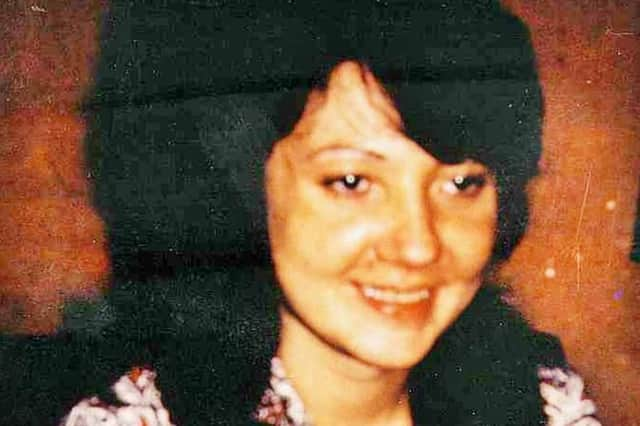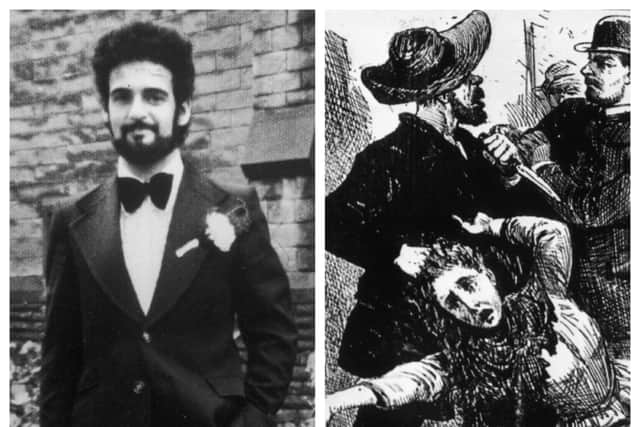Katherine Kelly and Daniel Mays talk new Yorkshire Ripper drama but did Peter Sutcliffe kill Preston's Joan Harrison?
and live on Freeview channel 276
Most people have heard of the Yorkshire Ripper. But, for some, the name conjures dreadful memories and picks at still weeping wounds.
Peter Sutcliffe earned the mantle with the brutal murder of 13 women and attempted murder of seven more across Yorkshire, Lancashire and Greater Manchester between 1975 and 1980. One of Britain’s most notorious serial killers, Sutcliffe cast a shadow that still lingers today.
Advertisement
Hide AdAdvertisement
Hide AdThere have been countless profiles, podcasts, books and dramatisations on Sutcliffe, his life and his crimes. Less has been told of those ensnared in his evil. The Long Shadow, ITV’s new drama, trains the lens on the victims, their families, and the police officers at the centre of the five-year hunt to find the murderer.


The dramatisation is anchored by the personal stories of victims and the remembrances of surviving loved ones. One family the narrative pivots around is the Jacksons. Emily Jackson was 42 when she was picked up outside a Leeds pub by Sutcliffe in January 1976. With the support of her husband, she had taken to part-time prostitution to assuage the family’s financial difficulties. She was Sutcliffe’s second confirmed victim.
Coronation Street's Katherine Kelly is Emily, while Line of Duty’s Daniel Mays plays her husband, Sydney. Twenty-six-year-old Shaun Thomas plays Neil Jackson, their son, who has given his blessing for his family’s story to be told.


Preston and Chorley link to notorious case
But for one Lancashire family this drama will stirr up ubelievable grief as their daughter, sister and mother was thought to have been killed by the Yorkshire Ripper.
Advertisement
Hide AdAdvertisement
Hide AdJoan Harrison, nee Riding, was a bubbly, house-proud and loving, mother-of-two, who worked sporadically as a machinist and shop assistant before her life took a turn for the worse when she began drinking heavily and experimenting with drugs.
Brought up by her parents in Chorley, she attended St Mary’s School in the town, before moving to Preston with her first husband, with whom she had two daughters, Maxine and Denise.
But life at the family home, in Miles Street, near Moor Park, had turned sour, the marriage broke up and her husband died shortly after.
She began a new relationship with a much older man, 34-year-old Wilf Roach, who she moved in with and lived for eight months. But, as her descent into alcoholism and drug-use continued, that relationship foundered when Wilf suspected she was unfaithful.
Advertisement
Hide AdAdvertisement
Hide AdSoon after, Joan began falling behind on her mortgage payments on the Miles Street house and eventually lost the property. Her beloved daughters were taken into care, one to live with Joan’s mother, the other with social services.
She then married Paul Raymond Harrison, a carpet fitter from Burholme Road, in the Ribbleton district of Preston.
The 27-year-old later told an inquest into her death he had not lived with his wife for two years because of her heavy drinking and drugs use.
In the months before her death, Joan lived at bedsits in Frenchwood Street and Brackenbury Road before beginning a relationship with her 47-year-old landlord David Keighley at East View, Deepdale.
They were due to be married the following June.
Advertisement
Hide AdAdvertisement
Hide AdHe later spoke of his love for Joan and explained how he had tried to give her a stable home life but spoke of her terrifying drinking binges.
Joan’s elder sister Margaret Upton had seen the writing on the wall.
She told the Lancashire Evening Post that in the last six weeks before her death Joan had become a “fleeting memory” to her sister’s family. Once a regular visitor to the household, in Havelock Street, Margaret’s children would innocently tell her, “Auntie Joan is ill again.”
Margaret knew better, her sister often came to the house drunk.
Advertisement
Hide AdAdvertisement
Hide AdWarned by doctors about her failing health, Joan turned more to the bottle for solace and to ease the worst effects of her chronic bronchial asthma, which she had battled since childhood.
Margaret said, “I knew something would eventually happen to her... things were going that way but I never thought she would be killed.
“It was pitiful really, the way she went. She had been a good mother and her kids thought she was great though they were not living with her. There was another side to her so many people will never have known and she did love her kids such a lot.”
By 1972, Joan was plumbing the seedy depths of Preston, losing access to her children as she was unable to cope.
Advertisement
Hide AdAdvertisement
Hide AdBy the time she was brutally murdered in 1975, she had already stared death in the face once – doctors battled successfully to bring her back to life in a Preston intensive care hospital bed after she imbibed a cocktail of drink and drugs, triggering a massive asthma attack. She had turned blue and her heart stopped beating.
Joan was mixing with the dregs of society and spent much of her time in Preston's more downmarket pubs and clubs.
Joan was unemployed and lived off social services. Her life became a living nightmare.
Despite rumours she was on the game, Joan was never arrested nor cautioned for prostitution.
Advertisement
Hide AdAdvertisement
Hide AdOn the day she died, she had been working voluntarily in St Mary's Hostel for the homeless where she had a job as a part-time cleaner, washing plates and cleaning up.
It was Thursday November 20, 1975, and after finishing her shift at lunchtime, Joan went out with colleagues for a drinking session at the nearby St Mary’s pub and later moved on to the pubs in the New Hall Lane area.
She was the worse for wear, or as warden Ian Finchen described her, “a little drunk”, when she returned to the hostel later and needed a lie down on one of the rest beds.
From the hostel, Joan returned to the home in East View, Deepdale, which she shared with Mr Keighley.
Advertisement
Hide AdAdvertisement
Hide AdAnxious to get a late-night drink, she left again at 10.20pm, walking the damp and badly-lit streets into the town centre.
It was the last time that Joan would be seen alive.
The first sign that anything was amiss was when Mr Finchen reported her missing on Saturday morning.
The following day her sister Margaret received a knock on her door that she would never forget.
“Your sister is dead,” a policeman told her.
Joan had been found battered to death in a disused lock-up garage, in Berwick Road, Avenham.
She was just 26.
Her body was discovered lying face down in a pool of blood.
Advertisement
Hide AdAdvertisement
Hide AdThree weeks before Joan was killed Wilma McCann, 28, was struck twice with a hammer then stabbed 15 times and her body dumped in a playing field, in Leeds.


The mother-of-four was the first victim killed by the Yorkshire Ripper.
Over the following five years the serial killer struck 20 at least times butchering 13 women to death and leaving others seriously injured.
The crime spree shocked the nation and left women living across the north of England in the grip of terror.
Advertisement
Hide AdAdvertisement
Hide AdIn 1979, the Lancashire Evening Post, reported that the Ripper was thought to be responsible for Joan’s murder.
‘Skid Row link-up in Ripper hunt,’ said the headline.
The story revealed a top level meeting between Lancashire CID and their counterparts in Yorkshire had led to a sharing of information.
But was she a victim killed by the Yorkshire Ripper?
Kelly, 43, and May, 45, discuss taking part in the series.
WHY WERE YOU INTERESTED IN BEING INVOLVED IN THE SERIES?


KK: From the off, it was very, very clear that it was a re-examination of that story. There’s no need for any more about Peter Sutcliffe. It’s well-documented. But what’s not well-documented is the victims, and the victims that survived. It was very clear that the spotlight was on them. And the fact that Emily was the only victim that was married, and the complexity of that, and then the fact that Neil Jackson was on board (with the making of the programme) and it was with his blessing, made a big difference.
Advertisement
Hide AdAdvertisement
Hide AdDM: I did Des with Lewis (Arnold, the director). So I knew first-hand how good he was. And I knew he was going to apply the same level of talent that he’s naturally got to this story and all the victims. So it was the same as Katherine – a complete no-brainer when you get that combination of script, director, ensemble of cast. It’s a very difficult subject matter to talk about and to bring to the screen. But at its heart it’s got an amazing truth and integrity.
DANIEL, YOU MET NEIL BEFORE FILMING – WHAT WAS THAT EXPERIENCE LIKE?
DM: He brought photographs of his mum that he had up in his kitchen or somewhere in his house, and he wanted to show them to me. One was a family photo… I didn’t quite know how to broach it. How do you talk about it? But he was so generous and so open and amazing with the vulnerability showed to me in the meeting. It really helped fuel the performance.
CAN YOU TELL US A BIT ABOUT SYDNEY AND EMILY?
DM: Lewis always described Sydney as impotent, not literally but metaphorically. She (Emily) was the driving force of that household. She ran the books on the contracting business, he couldn’t read and write, he couldn’t drive. I was fascinated by this northern guy from the 1970s.
Advertisement
Hide AdAdvertisement
Hide AdKK: She is a fascinating character. The fear and terror that was looming for them at the time was not this serial killer because that didn’t exist. There’d been one murder and it was a case that hadn’t really been particularly publicised at that point. The fear and terror that was looming for them was of being evicted and not being able to feed the family.
And the enterprise in her – she taught herself to drive, they had animals, she had fruit and veg, she had about three jobs. She drove him to work and did all the books for them. Nowadays, she’d have absolutely aced The Apprentice, she was that kind of woman.
KATHERINE, HOW DID BEING FROM YORKSHIRE INFORM YOUR CHOICE TO TAKE ON THE ROLE AND HOW YOU APPROACHED IT?
KK: I suppose when you grow up in that long shadow, then you kind of have to step out for a second to re-examine what that is. You won’t meet anybody where I’m from that doesn’t have some association with Peter Sutcliffe, or his family, or where he worked, or one of the police officers that caught him, or the pub he drank at. By proxy, everybody knew him. It’s just there. And so you’ve got to step out and look at it with fresh eyes and then go back into it, because I knew so much without knowing I knew so much.
Advertisement
Hide AdAdvertisement
Hide AdIt changed everybody’s life on a day-to-day basis. It changed what people did, how people ran their lives. Because there was a monster on the loose. And it could be you, it could be your neighbour, it could be your brother, it could be your dad. And when he was caught there had been so many false alarms, ‘ah we’ve caught him’, that it took a long time for the pressure to drop because he wasn’t even truly believed. And then on a wider scale, it changed policing forever. You can tell the police didn’t speak to each other.
The Long Shadow airs on ITV1 and ITVX from Monday, September 25 at 9.00pm.
